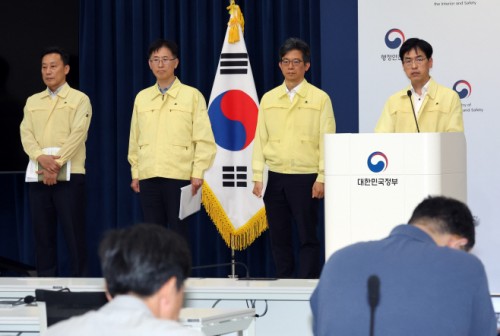 |
| Kim Min-jae, first deputy chief of the Central Disaster and Safety Countermeasures Headquarters (vice minister of the Ministry of the Interior and Safety), briefs at the Government Complex Sejong on October 1 about the fire affecting the National Information Resources Service’s administrative information systems. / Source: Yonhap News |
A total of 101 government IT systems have been restored after the fire at the National Information Resources Service (NIRS) headquarters in Daejeon, but the shared cloud storage known as “G-Drive” was completely destroyed, making recovery virtually impossible and causing extensive data loss, particularly at the Ministry of Personnel Management.
As of 2 p.m. on October 1, the Central Disaster and Safety Countermeasures Headquarters said 101 out of 647 administrative information systems were back online, including 21 of 38 top-priority, Tier-1 functions. The overall restoration rate stands at 15.6%, while Tier-1 restoration is at 58.3%. For the 96 systems housed in the burned-out Server Room 7-1, the government has begun moving them to the Daegu Center’s public-private partnership (PPP) cloud zone, starting with equipment intake.
Vice Minister of the Interior and Safety Kim Min-jae said at a briefing that an on-site situation room has been set up to directly manage the process and that “all resources will be mobilized for rapid restoration.” Each day, 576 specialists are being deployed to the site, and the dust-removal crew has been expanded from 20 to 50 to speed up the work.
The core problem is the “G-Drive.” Both the primary G-Drive servers and their backups, located in Server Room 7-1 on the fifth floor, were destroyed in the blaze. While most ministries stored files on both PCs and the G-Drive, the Ministry of Personnel Management followed Interior Ministry guidelines requiring exclusive storage on the G-Drive, leading to especially severe data losses.
The G-Drive is a common government cloud system designed for central-government officials to store policy documents and work files instead of on their PCs. Under security rules, PCs cannot retain files and are reset upon reboot, forcing all materials to be saved only to the G-Drive. Because off-site backups are limited, a total server loss like this makes recovery impossible—a structural vulnerability now laid bare.
While restoration continues, the government is securing workarounds. Alternative services have been arranged for 267 of the 546 systems still offline (49%). Citizen inquiries through the 110 and 120 hotlines have centered on when everyday services such as the Integrated Real Estate Information System will return. As platforms like Government24 and unmanned certificate kiosks resume, call volumes are trending down.
Measures to ease public inconvenience are also being rolled out. Korea Post will directly purchase 3.3 billion won worth of goods from small sellers on its shopping platform and waive sales commissions for one month after normalization. The Ministry of SMEs and Startups will help about 2,400 firms list on private online malls and provide vouchers worth 2 million won per company. The Tax Tribunal will treat appeals filed within 14 days after the disruption is resolved as meeting the statutory deadline.
Addressing concerns about a security gap, Vice Minister Kim said national network security appliances remained operational. Although the Daejeon center’s network was briefly halted, communications and security systems were brought online before systems were restarted, ensuring there was no security vacuum.
Most Read
-
1
-
2
-
3
-
4
-
5
-
6
-
7





















